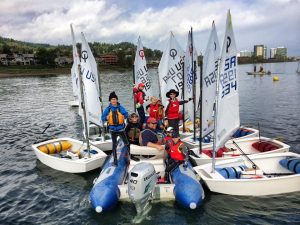
Reliable Racing having a sale through the end of April on our Pro-Tec helmets and custom helmet covers.
- Pro-Tec Ace Helmets: Reg. $54.95, Now $43.96
- Custom Helmet Covers: Reg. $14, Now $12.60

Reliable Racing having a sale through the end of April on our Pro-Tec helmets and custom helmet covers.
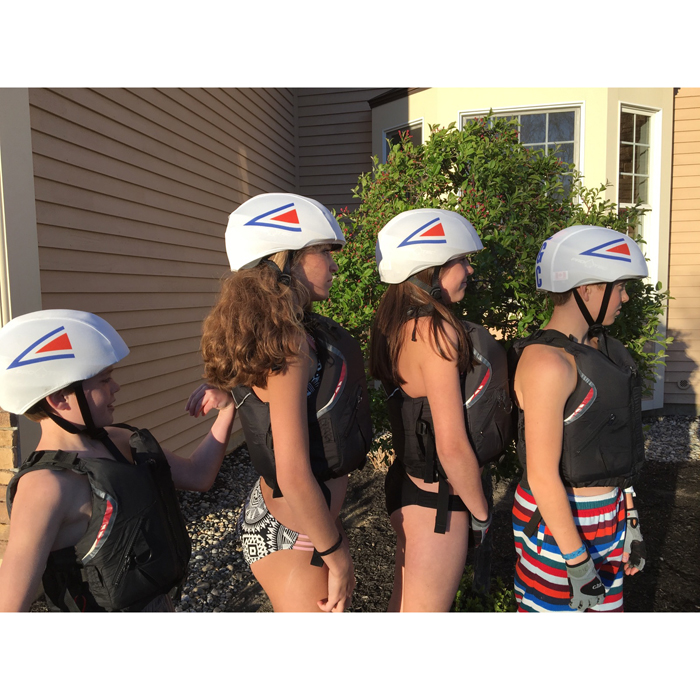
Friday, 9 March 2018– Here we go! Another spring filled with thrilling and highly competitive college team racing. Please support our sponsors who bring these rankings to you: Dynamic Dollies & Reliable Racing. My sailing team uses Dynamic dollies, as many do, and as good as their product is, I can say that their service, support, and professionalism are all even better. As for Reliable Racing, more and more we see competitive sailing improving and upgrading both the look and feel of the sport. Reliable Racing is ready to help your team do just that, with pinnies, sailing-specific helmets, and more.
The season is already underway, with results to give our coaches some data, including the Sharpe Trophy at Brown & the Bob Bavier at Charleston.
Top 5:
To see the FULL rankings and all the analysis, CLICK HERE!
Rankings are an average of our five panel team, Dillon Paiva (Navy), Johnny Norfleet (fordham), Bill Healy (Yale), Clinton Hayes (Stanford), and Ken Legler (Tufts). Complete with comments, these rankings help provide our fans and players alike not only with thoughts on who’s who, but also they offer quick analysis and glimpses into the teams themselves in the coaches comments. Enjoy!
About Sail1Design
Sail1Design is a grassroots organization, by sailors for sailors, dedicated to the youth, high school, college, and one-design sailing communities. Born in 2007, Sail1Design has grown considerably, and reaches out to all sailors wishing to enjoy and learn more about our sport. We have three main areas of business:
SAILING/MARINE INDUSTRY CAREER CENTER & JOB BOARD
We offer sailing’s #1 Career Center and Job Board, always chock full of incredible sailing job opportunities. Our comprehensive career center also offers job seekers the ability to create their own web page, highlighting their experience and posting their resume. Likewise, employers can search our resume database to find the right match for that open position. Sail1Design is proud also to be the official job board of the Intercollegiate Sailing Association (ICSA), the US High School Sailing Association (ISSA), and US Sailing.
MARKETPLACE & PROFESSIONAL BROKERAGE
Unique to the industry, Sail1Design hosts and manages an active private, by-owner marketplace, focusing on performance and one-design sailboats & gear. For all boats under 25′, our ads are free. What makes us different is that we also provide, side-by-side, professional brokerage services as well. We have had great success helping our sailing clients market and sell their boats, using our powerful client base, social media, and the brokerage industries multiple listing service to ensure your boat gets noticed.
AIRWAVES NEWS & CALENDAR
S1D also hosts Airwaves, an interactive, user fed Sailing Calendar and informative Sailing News, Articles, tips, & more. Airwaves has developed a great niche in the sailing publication world, and now boasts a seven-member staff of dedicated sailors, all contributing to our varied content.
By Airwaves Senior Writer Taylor Penwell
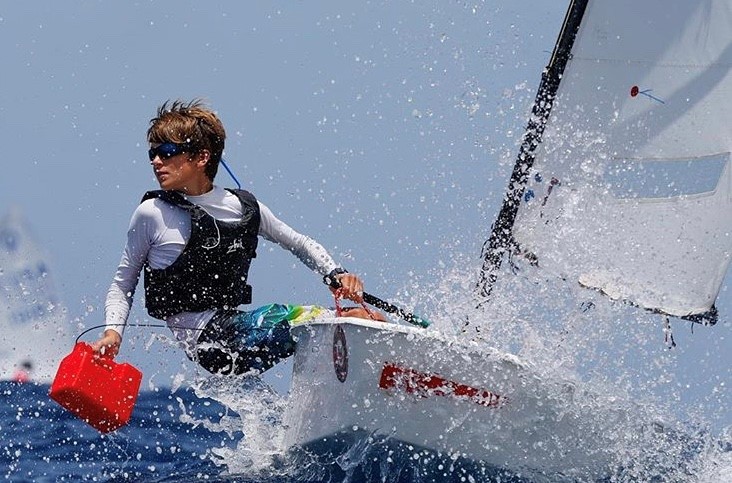
Please tell the readers and me a bit more about yourself Teddy.
I am a junior at the Antilles High School on the US Virgin Island of St. Thomas. I enjoy watching and playing sports, hanging out with my friends, and of course sailing. I currently sail the Nacra 15, Club 420, and sail on the Antilles High School Sailing Team.
Where are you from Teddy?
I was born in Chicago, Illinois, and lived there until the age of 7 when our family moved to St. Thomas. I have lived here in St. Thomas ever since.
Where did start sailing?
I first started sailing at the St. Thomas Yacht Club.
What age did you start sailing?
I first started sailing when I was 9, and when I was 11 I began sailing competitively.
What drew you to racing?
The curiosity of how it works and the idea of doing a competitive sport on the water drew me to racing.
You had a very successful optimist career, tell us about your top finishes and successes.
My best finishes in the Opti class started at the end of the summer of 2014. This was when I won my first big regatta, the New England Championship. The following regatta was the Opti Midwinters located in New Orleans, Louisiana, and I won that regatta too. Then at the end of 2014, I won the Orange Bowl Regatta in Miami. In the spring of 2015, I finished second overall at the South American Championship. Later in that summer, I finished 2nd overall in the North American Championship. In my last regatta of my optimist career, I took 7th place at the Optimist World Championship in Poland.
What do you attribute your success in the optimist class to?
Many things led to my success in the optimist class. The most significant attribution to my success was practice. During my opti career, I sailed around 4-5 days at first with the coach Santiago Galan and later the coach Augustin Resano. I also participated in many international regattas and gained experience quickly. After two years of intense practice and many regattas, I was able to reach the top of my fleet and win regattas.
How often do you train?
Now, I train about 3-5 days a week.
The Virgin Islands has produced some amazing sailors in junior sailing, what type of things do you think separate sailors from there compared to other places?
The Virgin Islands has produced some amazing sailors because of its junior sailing program and the amazing weather we get. Many of the best sailors from St. Thomas began in the optimist with the junior sailing program at the Yacht Club. Their really good coaches helped the sailors get off to a great start in their sailing careers. Another advantage the Virgin Islands has, is the weather. We can sail year round and rarely miss a day of sailing because it is almost never too light or too windy.
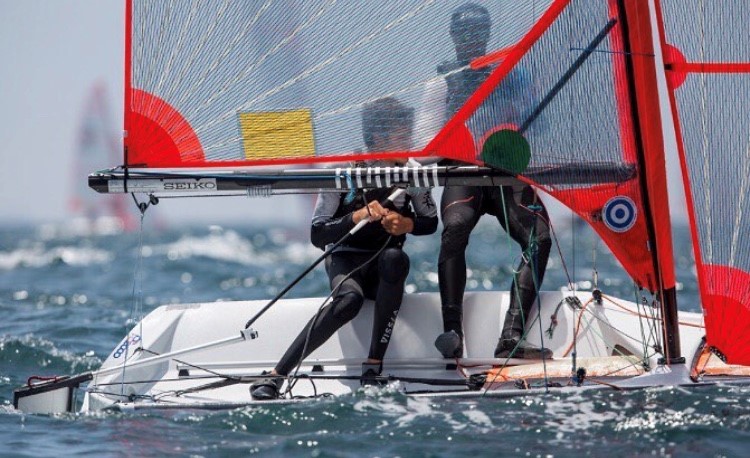
At first I sailed high school sailing with Antilles, some Club 420, which are basically the same as high school except with trapezes and spinnakers, and the 29er, which is a fast and high performance boat. Now, I still sail the same boats except that I sail the Nacra 15, an even faster boat, instead of the 29er.
What your top finishes were in all the boats you’ve sailed in?
In the Club 420, I’ve gotten 12th at Orange Bowl in 2015 and 7th in 2017, both with fleets of about 100. I was 10th in both the Hyannis Regatta in 2016 and the Buzzards Bay Regatta in 2016. I have also won a few smaller regattas in the Midwest and in St. Thomas. In the 29er I finished 8th at New England’s in 2016 and 7th at Orange Bowl in 2016. Our high school sailing team won the Baker (team race) National Championship and finished 6 in the Mallory (fleet race) National Championship. In the Nacra 15 I’ve gotten 4th in two regattas this past fall/winter with about 15-20 boats and won a small regatta two weekends ago with 4 boats in Port Charlotte.
How has the transition from a single-handed boat to double handed boats been like?
The transition was not very easy. At first I found it kind of annoying sailing with other people. Even if you sail your best and they make a mistake, then you do worse than what you could have done. It also stinks when you are the one that makes a mistake because then you feel bad for causing your teammate to do worse than what they could have been doing. Another challenge with double-handed boats is finding your teammate. Even if you were to sail with the best sailor in the world, you would still need time to get used to sailing with them and figuring out what jobs are whose on the boat before you could perform your full potential. The other problem with teammates is finding one. For example in my 29er career, I believe I ended up sailing with 10 or more different crews in a time span of a year and a half. This made it extremely difficult to perform at my full potential because I was always still getting used to sailing with my new crew. Although, now I do not mind it as much. For the past 6 months I have been mainly just sailing with my younger sister Mia, instead of switching around crews.
What are some of the characteristics you look for in crew members?
The most important characteristic, in my opinion, for a crew, is their determination and desire to learn more and become better sailors. I like crews that ask questions, even if they think they are dumb questions, because this shows that they are interested in learning how to become a better sailor. I also like crews that are athletic, because after all it is a sport, and being naturally athletic and strong makes a huge difference.
Your high school, Antilles won the National Championship last year. Tell us a bit about that experience.
Winning the High School National Championship was one of the best experiences in my life. I remember we were winning the regatta, but not by much going into the last race, so the race still mattered and there was a lot of pressure. We were all very anxious to win, but scared to loose. Luckily for us, right after the start, the race committee saw lightning, canceled the race and sent us in ending the regatta. I still remember that feeling of joy and accomplishment when our team found out that racing was done and we won. We sailed in celebrating. Still to this today I cannot believe that we won Nationals and when I think of it it reminds me of how far we have come and how great of sailors we are.
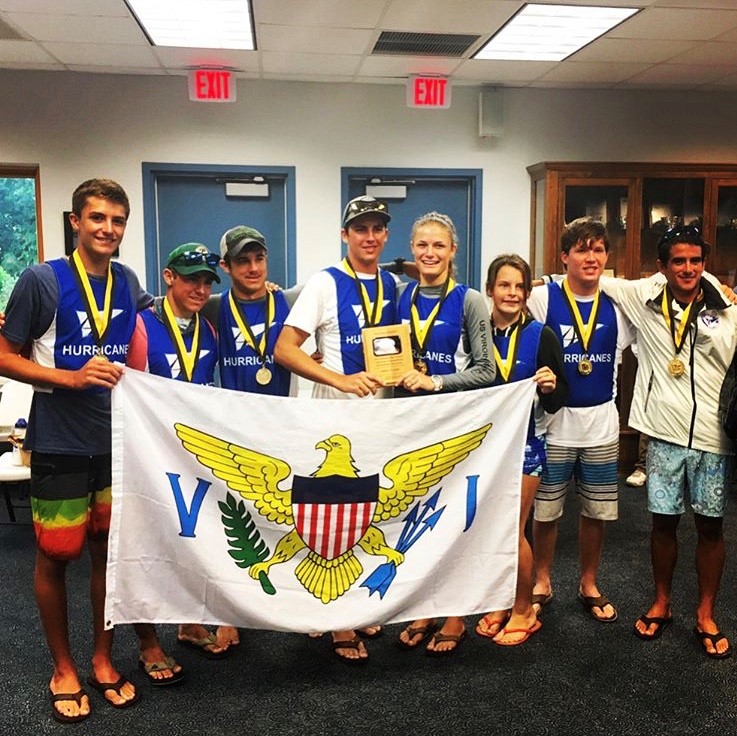
My 29er career has had its ups and downs. I’ve had a few alright finishes, but never amazing ones. One of my main problems was finding a crew that I could sail with for awhile. In the end I found it frustrating and wanted to start fresh in a new high performance and fast boat, the Nacra 15.
What are your goals moving forward with sailing? Are you planning on doing an Olympic campaign or attending a college sailing program in the United States?
Moving forward I plan on attending Yale University with my older sister Grace Ann and sailing on their amazing college sailing team. Right now Mia and I are trying to qualify for the junior Olympics in the Nacra 15. It’s hard to tell if I’ll make an Olympic campaign, but if the Nacra 15 goes well, I can try to qualify for the Olympics in the Nacra 17 (a bigger, faster, and more advanced version of the Nacra 15).
What drives you to keep getting on the water and competing?
What motivates me to practice and compete is the love I have for the sport. I love the water, traveling, and meeting new people that comes with sailing. I also love the feeling of winning which I assume everyone does, and I am willing to do what it takes to achieve that, which is getting as many hours as possible on the water.
When you’re not sailing, what other things do you enjoy doing?
I enjoy other sports like basketball and football. When I was younger and during my optimist career I played basketball as well as sailing. Now I don’t play anymore, but I still love to play pick up games of basketball and football with my friends. I also like watching TV, boating, and hanging out with my friends.
by Emily Shanley-Roberts, Tufts University Class of 2018
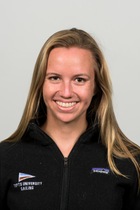
I was born with a spine that curves in-and-out, side-to-side, however it pleases. It is the worst-behaved thing about me. This curvy, nonconforming piece of equipment is the first symptom that was noticed; it brought me to orthopedists and physical therapists for much of my young life. As I got older, my symptoms were exacerbated by years of ballet, injuries, and wear from athletics. My back pain grew to my shoulders, my knees started to age way too quickly, and I became exhausted. Halfway through high school I began to rely on daily physical therapy to continue to be able to compete at my beloved sport. For a while, it worked. I did not anticipate that my pain would get worse.
When I began sailing at Tufts, I wanted to be the golden child, the great investment of Ken Legler’s coaching. I tore my MCL in practice and sailed through it. I spent days in pain and didn’t know that others around me felt it too – I did not know that it was okay to take a break. I continued to do physical therapy, trusting that I just needed to repair my muscles. By May 2015, the pain was so bad that I could barely walk. After each race at team race nationals, my skipper would pick me up out of the boat, carry me to a chair, and set me down. Again, I thought that a summer off 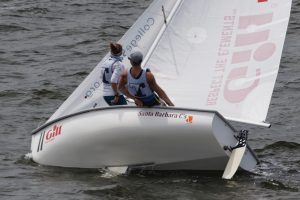
This summer, after my sixth national championship and third dislocation of my shoulder, I realized that this was more serious than just a couple of tired muscles and a screwy back. A series of MRIs and tests told me that I had two options: sitting out my senior year as I got surgeries, or managing the pain to be with my friends. My genetics dictate that I’m ‘loose-jointed’ with tendencies to swell up like Violet Beauregard in Willy Wonka and burn through cartilage like a blowtorch on North Field. Every missed step takes off my kneecap, every improper roll-tack pulls my shoulder out of alignment, and the chronic pain leaves me exhausted.
Discovering that I was not going to “get better” was less remarkable than the simultaneous discovery that some of my friends hurt too. Pain is common among athletes, with a spectrum ranging from muscle soreness after competing to debilitating chronic pain. As I’ve become more comfortable with communicating my limitations, my teammates have stepped forward to help me continue to succeed and to communicate their own limitations. The latter has helped me to feel accepted when I otherwise feel so very different from them. I am privileged to be able to help them manage their pain and let them know they’re not alone.
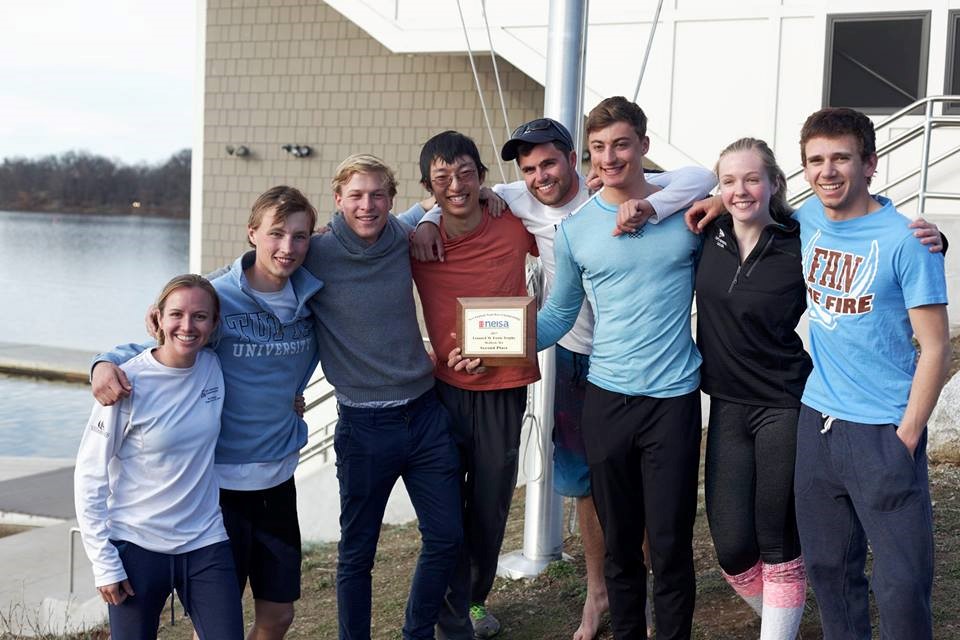
Moments like that define our team. Some of us cannot lift boats, so the others lift the boats. Ken won’t sail me when it’s breezy (unless it’s a championship), so this weekend I’ll coach the team race team. Moments like that define my experience of this sport, as well: I have friends around the ICSA that help me up the dock and fellow crews with whom I’ll trade kinesio tape and advil. If it weren’t for moments like these, I wouldn’t make the decision each weekend to throw all my energy into competing. The friendships I’ve made over the years make that decision every morning – that trade-off between comfort and excitement – easy. Despite how I feel at the end of each day, I choose to get back in my boat and compete for the most supportive team I could ask for against the friends that I hope to have for life. After all, the beauty of college sailing is that my limited ability does not limit my ability to compete and succeed – it just presents a different challenge.
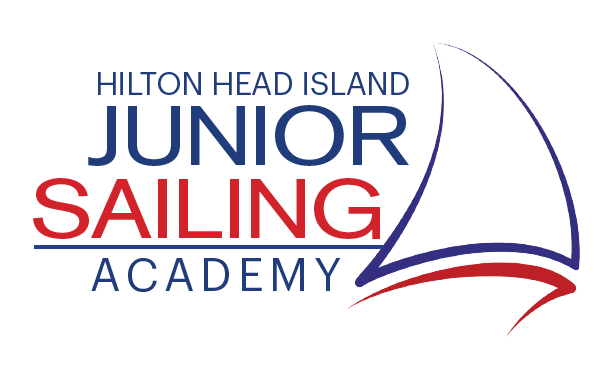
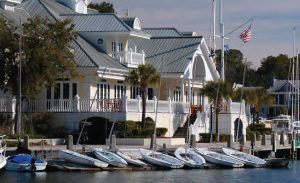
ABOUT HHIJSA
Hilton Head Island Junior Sailing Academy offers a Full-Time, Sailing Academy and Summer Sailing Camp, programs are designed to help a student who wants to focus on sailing for the year building their resume by competing in national ranked regattas.
A key differentiating factor of our boutique junior sailing academy is that our students have an opportunity to compete in regattas throughout the southeast. This opportunity further develops the skills and confidence of each and every student and helps with collegiate exposure.
Hilton Head Preparatory School provides students an opportunity to find their niche, fuel their passions, and work individually with highly-educated faculty through a rigorous curriculum, extraordinary community service programs, and a vast number of extra-curricular activities. From Program Director Mark Newman: “We believe in a well-balanced approach to our junior sailing academy students, as well as life lessons, and a dedication to the well-rounded success of your son or daughter is our ultimate goal. Our team of highly experienced sailing coaches provide individual training and focus on each and every student who attends our sailing academy and school. “
OUR STAFF
The entire Staff at Hilton Head Island Junior Sailing Academy is U.S. SAILING certified. This means that they not only have been trained and tested both on-the-water and off as sailing instructors, they have also been trained and certified in CPR and First Aid. They have extensive teaching, coaching, and racing experience. The program director is Mark Newman, who is a U.S. Sailing level III certified coach who has a vast experience in high school, optimist, J70, and summer program management.
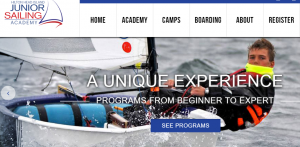
The single-handed trainer at Hilton Head Island Junior Sailing Academy for students up to 15 years of age is the Optimist Dinghy, sanctioned by the South Atlantic Yacht Racing Association (SAYRA), and the most popular class of boats ever built.
The crewed trainer is the club-420, a popular high performance centerboard sloop. These Boat’s are used for introduction to the sport when instructors take beginners for their first sail and also for training intermediates and racers in crew coordination, handling of the jib, sailing “wing-and-wing” downwind, and other sloop skills.
The Harbor 20 is a true one design boat that is raced here at the club every Wednesday night. It gives the sailors the ability for young sailors to experience small keelboats and work cohesively with a crew of 2 or more.
The acquisition of a J/22 has will also help prepare sailors for one design racing as well as symmetrical spinnaker team work. This boat is commonly used for the high school keelboat championship.
The J/70 is a lightweight rocket ship that will take sailors downwind with its asymmetrical spinnaker, and will encourage sailors to understand the concepts they have mastered in Optimist, 420, and Harbor 20’s have relevance in one design keelboat racing.
Please visit our website http://www.hhijsa.com/ to learn more about us!
Written by Chris Klevan
Sailors are artists. They have a vision towards which they spend thousands of hours refining their craft. Though sailing is an extremely demanding sport physically, it is equally strenuous mentally. How sailors operate on a day to day basis is as influential to how they operate when something as big as an Olympic dream is on the line. You can learn a lot from these small moments. This interview series is a window into minds of the best sailors today, how they work, what makes them tick, what about them, as people, has turned them into the sailor they are today.
It has been quite a year for Erika Reineke. She was named the Quantum Women’s Sailor of the Year, the Intercollegiate Sailing Association’s award for the best woman’s sailor in May of 2017. A couple of months later, she was named the Rolex Yachtswoman of the Year. She was the Noshima Olympic Week Champion. Many see her as the favorite to represent the United States in Tokyo in the Laser Radial, where she will be a legitimate contender to medal. However, Erika will tell you that her mission is to, simply, be the best she can be everyday, inspire those around her and enjoy the experience along the way. Her love of the game is truly inspiring and after watching her sail in the college game for four years at Boston College, it is hard to doubt she isn’t up to the challenge.
You can find more information on Erika’s Olympic Campaign at http://www.erikareineke.com/.
Hey Erika! How’s it going? Thanks for taking the time to talk. How’s Spain?
Hey Chris! Palma is beautiful right now. My training partner from Canada, Sarah Douglas, and I are here for enjoying some winter training before the Princess Sofía Event starts up in April. We had a few glamour days at the start of the camp with sun and warmer weather but yesterday was a bit of a shock. There was no sun, it was pouring down rain, and the air was so cold that we didn’t take our jackets off the entire practice. Even the girls from Finland, Sweden, and Great Britain were chilled to the bone. With icicles forming at my finger-tips, I was still so excited to be out there training with my competitors, all of us trying to out work each other. Nothing is better than that.
Question: What’s the first thing you think about when you wake up in the morning?
Answer: Well, mornings are my favorite! Big time morning person. The first thing I think about is getting my hands on a cup of coffee and some Crispix cereal. After I satisfy my stomach, I put my speakers on to get ready for the first gym session of the day.
Q: Do you like sushi?
A: Sushi is definitely one of my absolute favorite foods. Anything with avocado and salmon is high up on my list.
Q: What has been the most rewarding part of your experience?
A: The most rewarding part through this whole experience is that I feel like I am finding myself and who I really am while I am pursuing my Olympic dream. There are so many sacrifices, setbacks, heartbreaks, doubts, and fears that run through an athlete’s mind that you are able to really to get know who you are through it all. You learn what makes you tick, what excites you beyond measure, and how you are able to bounce back after a loss. I feel extremely blessed to be able to find out who I am through this experience.
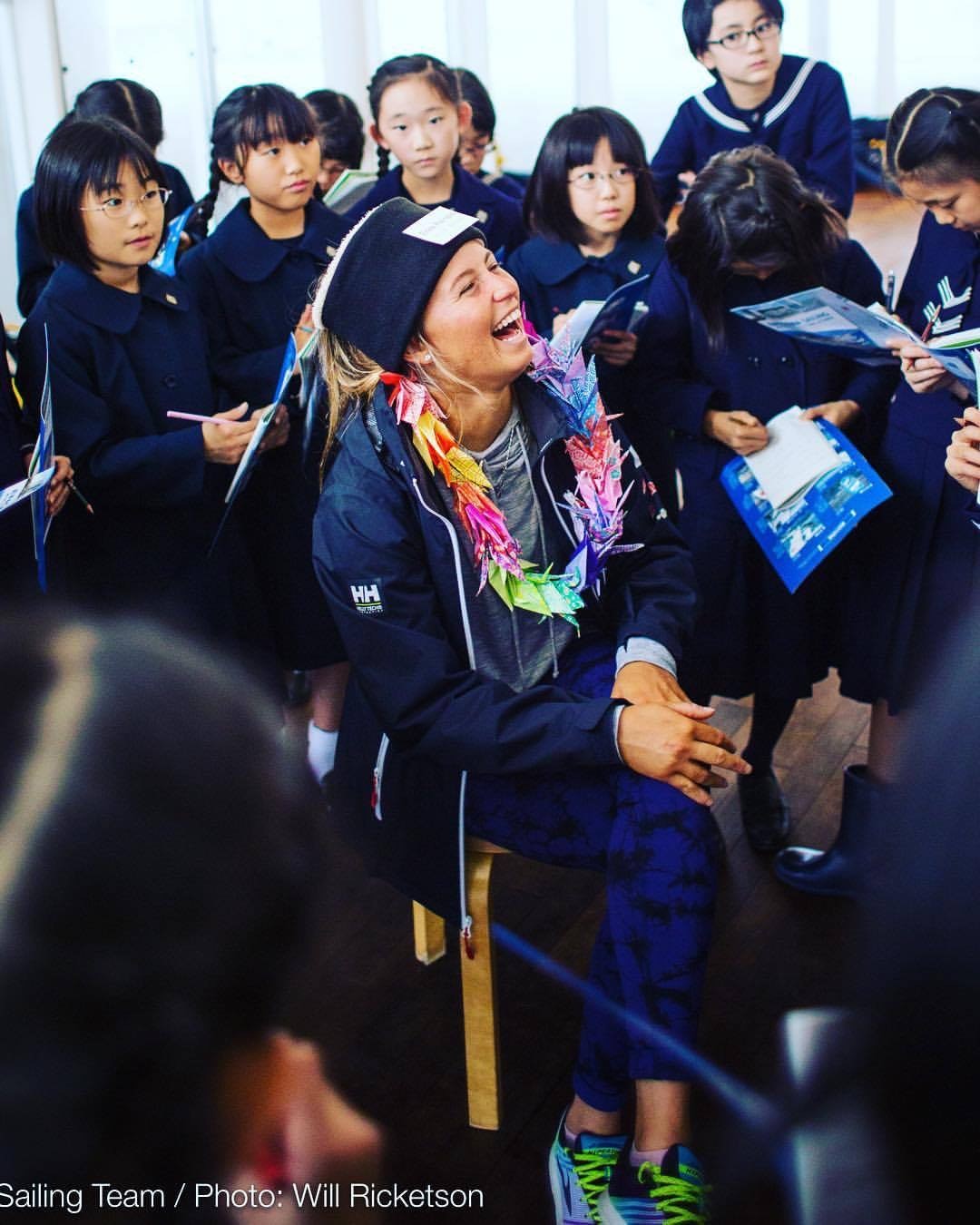
A: Honestly, it is an award that I never quite thought I could achieve. Just the other day I was looking at the past recipients and I couldn’t believe that my name was going to be added to a list containing some of the most outstanding women in sailing’s history. Though I am being recognized for the award, there are so many people that helped me to achieve it. There is nothing like winning an award with a team of people behind you. What seems like a solo victory actually extends out further than you can even imagine. I view this honor as a team victory for the Boston College Eagles and College Sailing who have pushed me to be my absolute best, the US Sailing Team and Staff who have supported my endeavors , and my friends and family who have stood by me through all the hardships that come with having an Olympic dream..
Q: What’s your earliest memory sailing? What has been your hardest moment, is there anything about campaigning that your currently struggling with?
A: My earliest sailing memory is going to the ocean for the first time and being absolutely terrified. I thought a shark was going to eat me. Now that I am older, my fears have moved on from sharks and towards the possibility of not achieving the goals I set for myself. I think that whether you are an athlete or not, everyone has this fear and the reason why it is so scary is because you are putting everything you have into it what you believe is you purpose in life. There’s a chance you might come out with a medal or victory but there’s also a chance you might have nothing at the end. Losing the 2016 Olympic Trials was a tough moment in my life. I didn’t know what to do with myself in the next few months. Everything I had worked for the last seven years dissipated in two events. The next hardest moment was the 2017 Laser Radial Worlds in Arrhus. I didn’t perform or feel like myself the entire regatta. Doubt settled in and I wondered if I had what it takes to be an Olympic Champion. On my 2020 campaign I am learning that there are going to be highs and lows. However, it is the athletes that can remain objective when it seems like the world is caving in around you that come out on top at the end.
Q: Talk to me about how you got into sailing growing up.
A: My parents, who do not sail at all, signed me up one day at our local club, Lauderdale yacht Club. While they were enjoying cold beverages at the patio bar on the weekends, I was out in the ocean crying begging the coaches to take me in.
Q: You’ve done some pro sailing, won the Melges 32 Worlds in Newport in 2016… How did that experience add to what you;re doing now?
A: The Melges 32 Team, Volpe, brought hope and light back into my life. I had been asked to join their team after the 2016 Olympic Trials. After such a devastating loss, the last thing I wanted to do was be anywhere near a boat so I was a bit hesitant to join their program. However, it was one of the best experiences of my life and it helped me find my way again. That summer I fell in love with sailing all over again and I will be forever grateful to the DeVos family for giving me that experience and my Volpe teammates for showing me what it means to give your life to the sport of sailing.
Q: What does it mean to you to represent your country?
A: It’s an honor and a privilege that comes with sacrifice and responsibility. Waking up in the morning and putting on my red, white, and blue gear with USA engraved across my back and on my heart is a surreal feeling. Everything you do is a reflection of your country and your responsibility is to make your country proud.
Q: Do you have any rituals when you sail?
A: I love listening to music before I go out. Having a song stuck in my head while I’m sailing makes being alone in a boat WAY better.
Q: How do you think your experience at Boston College and College Sailing, in general, helped you? How might it have hurt?
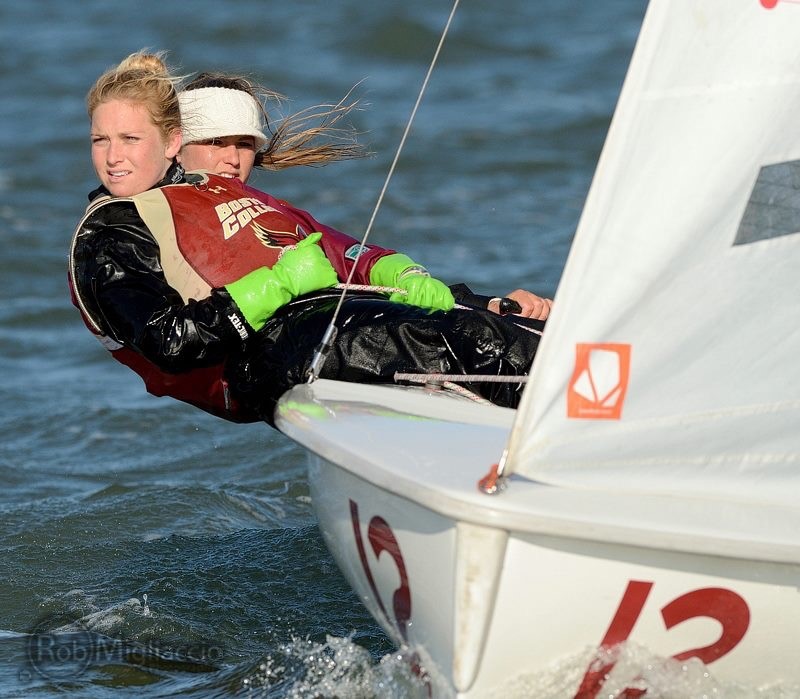
Q: You took a year off from Boston College, describe to me the thought process there.
A: This was never in the plan. I had performed extremely well during the summer of 2014 and the US Sailing staff believed that I had a shot at the 2016 Games and wanted me to take a year off to commit full-time. My initial response was, “No way.” I wanted to continue to sail with team and earn my degree in four years like I had set out to do. However, coach Greg Wilkinson and I looked at the bigger picture. The Olympics had been my dream since I was 12. If there was a chance I could make it, I was going to go all in.
Q: What was your high school experience like at St. Thomas Aquinas?
A: Overall, I hated high school. Everyday I’d be sitting in class staring out the window wondering about what it was like out in the ocean at that moment.
Q: What are you thinking when the boat is going well? When it’s going slow? (or does it never go slow anymore?) What’s your thought process after a beat with a net loss in boats/ after a bad start?
A: When the boat is going well, I’m usually singing in my head or thinking, “this is sweet!” When the boat doesn’t feel right, I start making adjustments immediately until I feel on pace. The biggest thing for me is to trust myself when something doesn’t feel right and not to make excuses like, “It was just a bad race or there was a wind shift.” After a setback, I hit the reset button and act as if the race had just started. Sometimes I make a goal for myself like, “okay, I am going to try to get up to boat ‘x’.” After I set the goal, I get in the zone and usually when I check back in later in the race, I have surpassed boat ‘x’ by a ton.
Q: What advice would you give a 13 year old with lofty sailing goals?
A: Have fun, smile, and remember how lucky you are to be able to such an beautiful and incredible sport.
Q: What would it means to represent America in the 2020 Olympics?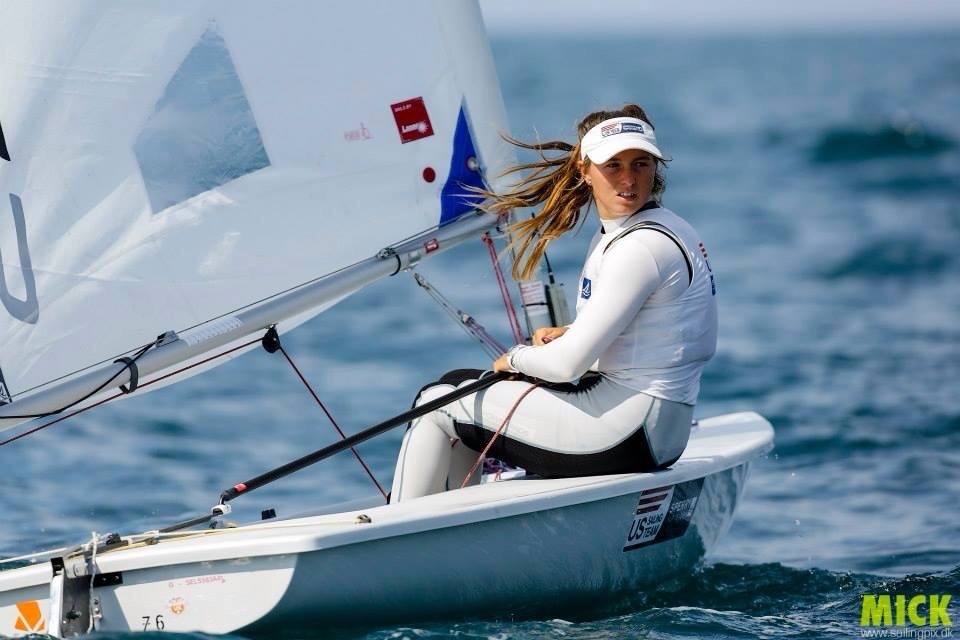
A: It would be a dream come true.
Q: I just finished watching the movie Creed, I’m so fired up right now. What motivates you?
A: I love watching movies or videos of athletes leaving everything out on the track. I feel a connection with them. Even though they aren’t next to me in the flesh, watching them comforts me because it is like seeing someone else who is going through everything I am. I feel like I am looking into a mirror image of myself. I highly recommend the movie Art of Flight. It show the excitement, hardship and beauty of sports with little words; images and possibilities flood the screen.
Q: It seems to me like you always have one of the best attitudes on the racecourse, why is that? Can you think of a time where you’ve had an advantage due to this?
A: I am definitely far from perfect but I do try my best to stay positive out there when things may not be going my way. I think what I have learned is to put things in perspective. I am in a sport where I get to be on the water every single day and most of the venues I sail in are absolutely beautiful. It’s really easy to get caught up in all the pressures and expectations but whenever I take a step back and admire where I am at and how lucky I am to be able to do what I do, it clears my mind and allows me to stay positive and chip away at races.
Q: How would you describe your workspace?
A: My room at home doesn’t have a desk so I rely on Starbucks’ coffee, tables, and jazz music to help me hammer out my work. If you are also inquiring about the cleanliness…I am annoyingly organized. I LOVE highlighting and tabs and notebooks and sticky notes. My view on the whole thing is that no one likes work so why not make it a little more fun with some fun colors? Office Depot has got to be one of my favorite stores.
Q: If you could spend time with a person, living or dead, who would it be?
A: Tom Brady.
Q: What do you like to do when you’re not sailing?
A: So many activities! I love skurfing, going to the beach, hiking, paddle boarding, swimming, snorkeling, walking my dogs, trying new restaurants, participating in my city’s local events like 5ks or sprint triathlons, learning a new song on the piano, and hanging out with friends and laughing about nothing.
Q: What advice would you give yourself 10 years ago?
A: I’d tell myself to play some Bob Marley and remember everything is going to be alright.
Q: What would you say is the Culture of your campaign?
A: My campaign is called the Amerikan Dream Campaign. I chose this title because I believe that investing your life in something you want to pursue is what the American Dream is all about. I want my journey to inspire others to take on their dreams.
Q: What’s your sailing philosophy?
A: Remember to smile.
Q: What inspires you?
A: My dad inspires me the most. He goes through so many battles every day at work. Sometimes he gets a victory and sometimes a loss, but he always keeps the big picture in mind and never gives up. Even on a day that he lost, he always able to smile at the end of the day.
Q: Do any books/ movies have an impact on your sailing?
A: Movies would include Art of Flight, Whiplash, Chasing Mavericks, and the 2017 CrossFit Games Documentary.
Q: How long can you do this?
A: That’s the great thing about sailing, you can do this sport forever. I am not sure what my path is after my 2020 Olympic Campaign. I just plan on living in the moment right now and seeing what happens down the road.
You can find more information on Erika’s Olympic Campaign at http://www.erikareineke.com/.
SEA Yacht Sales, a sailing company called Yachtpro (Thailand) – www.sailing-thailand.com is for sale! See FULL LISTING
We are sailors who work in the industry, rather than salesmen.
Sale includes:

2018 Brooke Gonzalez Advanced Racing Clinic
Sail Newport’s 2018 Brooke Gonzalez Advanced Racing Clinic will be held for the 17th year, Thursday, June 14th (mid-afternoon/report day) through Sunday, June 17th. Come learn from the best coaches and jump start your summer! The online application/resume builder is up and running at www.sailnewport.org/clinicresume Deadline for applications is Friday, March 30, 2018.
In 2001, Sail Newport and the family of Brooke Emmens Gonzalez embarked on a plan to create a high end clinic on the East Coast. We enjoy a reputation for the highest quality coaching, fabulous hospitality, a range of sailing conditions from flat tidal waters to choppy bay, open ocean , and a variety of wind conditions and remarkable guest speakers.
This clinic is held in 29ers, Lasers and Laser Radials, International 420’s, and Club 420’s. It is a BRING YOUR OWN BOAT Clinic, although limited charter boats are available for most classes. 
2018 PROGRAM
The 3 ½ day program will consist of lectures and on-the-water drills with an emphasis on boat handling technique, boatspeed and strategy. This will be combined with information on what it takes to reach your goals in sailing. The Clinic is led by Head Coach John Mollicone, and involves a stellar group of collegiate, Olympic and professional coaches . The coaching team in the past has included Ed Baird, Andrew Campbell, Bern Noack, Alice Manard Leonard, Isabelle Kinsolving Farrar, Elizabeth Kratzig, Jonathon Farrar, Skip Whyte, Sally Barkow, Ken Legler, Chris Rast, Stuart McNay, David Hughes, Leandro Spina, as well as many other top coaches. The 2018 Coach Roster will be posted shortly and will include two coaches from the current US Olympic Sailing Team.
On Saturday Night of the clinic, sailors are treated to a speaker from the highest levels of the sport. Prior speakers have included: Gary Jobson, Josh Adams, Dean Brenner, 470 Gold Medalist Kevin Burnham, Olympic Team Member Katie McDowell, US Sailing Team Technical Director Grant “Fuzz” Spanhake, and America’s Cup veteran and Volvo Race Competitor Ken Read.
The most important thing to remember is that when you get here at Sail Newport, there will be no reason to leave. Showers, food, spare parts, etc. will be here. Even locals will be required to stay on site for the full day. Our coaches want your undivided attention. The more you put into this clinic, the more you will advance because of it so we expect full commitment from the sailor athletes!
“These youth sailors receive the highest level coaching from some of the best sailors and coaches in the country” says Brad Read, Executive Director of Sail Newport. “Emphasis is on speed producing factors and techniques that work on long courses where speed is at a premium.”
Application deadline: March 30, 2018 (midnight)
Acceptances: Will be contacted via email by April 15th by Clinic Director and Head Coach John Mollicone
Selected participants will receive an online link to Sail Newport’s registration and payment gateway. At that time, you will be able to view the final coach list, updated schedules and charterboat information.
Information and the Online Application/Resume Builder can be found at http://www.sailnewport.org/Clinics/gonzalezclinic
For any questions please contact Clinic Director, John Mollicone, at [email protected] or Kim Hapgood at [email protected]
Another Family World Title
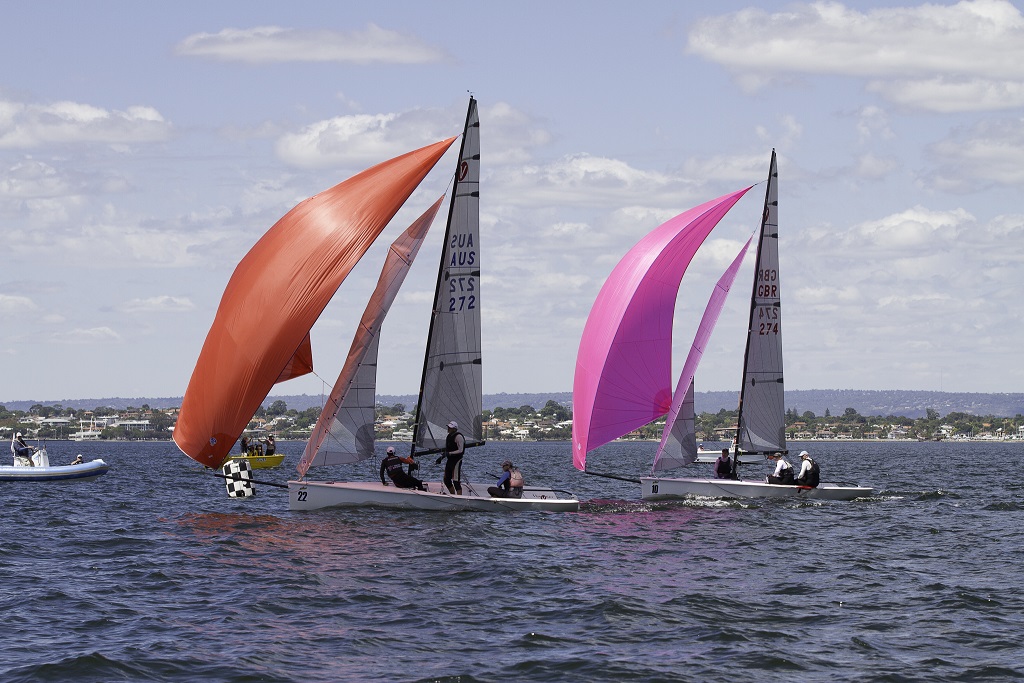
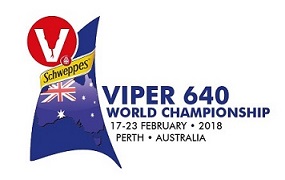
Justin Scott repeated his success at last year’s Worlds by finishing second with two third placings in the last two races. The American stated at the start of the campaign that he came to Perth expecting a top five finish, so he would have been delighted with his performance. Sailing with young local guns Conor Nicholas and Luke Elliot, the combination improved steadily throughout the regatta, with no worse than a third place in any of the final six races.
Match racer Keith Swinton, originally from Perth but resident these days in the USA, held down second place until the final day, bombing out with an early start in the last race of the series and allowing Scott to relegate him to third.
Conditions were difficult for both competitors and officials today. The forecast strong winds did not materialize and instead winds shifted between 140 and 190 degrees for some time this morning before finally settling enough to allow racing to proceed after a long delay. Wind strength never reached ten knots.
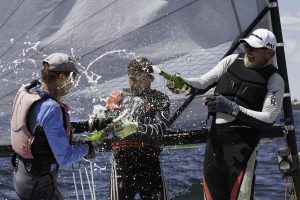
The consensus from competitors was a big endorsement for the championship. Most praised the organization and the way racing was run, the weather offered a little for everyone – from light breezes through to a testing 28 knot gear breaker, this regatta had it all.
For detailed results go to: http://www.topyacht.net.au/results/sopyc/2018/vipwlds/vipwlds/SGrp2.htm
Live video feed of the last moments of the final race, won by Jerwood just ahead of Britain’s Lawrence Crispin:
https://www.facebook.com/SofPYC/videos/1812823678748021/?comment_id=1812886718741717
Bernie Kaaks
Media Officer – Schweppes Viper Worlds 2018
News Flash: General Dynamics NASSCO is Hiring in multiple positions and levels!
General Dynamics NASSCO traces its beginnings to the industrial heart of San Diego, along the working waterfront of beautiful and historic San Diego Bay. The company has been designing and building ships in San Diego’s industrial corridor since 1960 and is the largest full service shipyard on the West Coast of the United States.
Today, General Dynamics NASSCO has locations on both the West and East Coasts. The company specializes in the design and construction of auxiliary and support ships for the U.S. Navy and oil tankers and dry cargo carriers for commercial markets. It is also a major provider of repair services for the U.S. Navy’s global force for good, with capabilities in San Diego, Norfolk, Mayport, and Bremerton.
In the past several years the popularity of the International 420 in the United States has grown. The I-420 is sailed around the world and is a popular dinghy sailed at school, club, open, national, and international levels. International champions including Spithill, Outerridge, and Burling have used the I-420 as a developmental boat to refine their boat handling and boat tuning skills. The US Sailing Olympic Sailing Committee endorses the I-420 as one of the six Olympic Development Classes for athletes identified as future Olympic prospects. This fast, exciting, and technical class is growing, and the United States is getting ready to host the 2018 World Championships at Sail Newport this summer.
The History
The I-420 was first designed back in the 1960’s by Christian Maury in France. The class developed rapidly in France and was adopted nationally as the youth trainer for the larger Olympic class International 470. In 1976 the International 470 was chosen as the Olympic double-handed boat, after that the International 420 increased popularity worldwide as it became a stepping stone into the 470, and a pathway to the Olympics. The International 420 is the youth development boat in 43 countries around the world, including the United States. Top international sailing champions have used this boat to build skills and move successfully on to bigger high-performance classes.
The Boat
The International 420 is a two-person trapeze and spinnaker racing dinghy. The monohull planing boat comes with a main, jib, and spinnaker. The boat is designed with 
For More Information on the I-420:
https://www.usi420.org
http://www.420sailing.org
News Flash: Willamette Sailing Club is Hiring a full-time Club Manager!
Willamette Sailing Club has been the center for small boat sailing in Portland since 1961. Located 5 minutes South of downtown Portland on the banks of the Willamette River, the club hosts a busy year-round schedule of racing, cruising, and learn-to-sail programs, as well as a number of river-related social and educational events, all of which are open to the public.
Learn more about this full time Club Manager position!
The club has over 300 members, and hosts numerous activities throughout the year. The WSC membership is comprised of a wide range of sailing enthusiasts. We have many members who primarily are interested in racing (from US Olympic team members to their first year racing a sailboat), members that just want a place to keep and launch their boat for day sailing, and some who just want a place to store their boat and enjoy the social aspects of the club. Whatever your sailing interest, WSC is a great club. The club hosts weekly races from February to November, 
